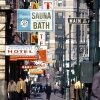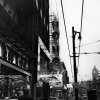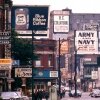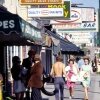Hastings-Chinatown
This content requires the Adobe Flash Player

Video Clips
Vancouver’s original downtown hub attracted thousands of people from surrounding neighbourhoods to shop, dine, and enjoy vaudeville entertainment in the first half of the 20th century.
The BC Electric Railway Company built the flagship terminal for its Interurban streetcar system at Hastings and Carrall in 1911. From that year until its closure in 1958, the Interurban brought 10,000 people to Hastings every day.
In the late ‘50s, the family-oriented commercial activity that used to thrive on Hastings moved west to Granville. By the 1960s, Hastings became a social hub for seasonal fishermen, loggers, and longshoremen. These sojourners replaced the vaudeville patrons and families who had flowed through in previous decades as new commercial businesses moved west.
The abundance of neon signage on Hastings Street became an issue starting in the mid-1960s, when anti-neon sentiments started creeping into popular conversation and resulted in a restrictive neon sign bylaw in 1974. One block south on Pender Street, the sparkling menagerie of neon signs in Chinatown faced a similar downward trajectory.
“Chinatown’s existence is owed to isolation, imposed isolation, by a relatively racist society.”
— Jim Wong-Chu, Chinatown historian
Prior to the anti-neon crusade and attendant sign bylaw, Chinatown was one of Vancouver's most striking neon neighbourhoods. The signs acted as a visual symbol of a community staking its claim as part of a city with a complex history of institutionalized racism.
As the signs were taken down as a consequence of the restrictive neon bylaw, Chinatown entered a period of flux. Through the ‘80s and ‘90s, most remaining neon signs deteriorated, and some were removed altogether. The fading lights of Chinatown’s streets reflected the waning intensity of civic attention to the neighborhood.
Now, bolstered by a new municipal granting program, neon is making a slow return to the Hastings and Chinatown neighbourhoods. But the streets have yet to match the vitality that characterized the neon heyday of previous decades.
Photo gallery
flickr FEED









































